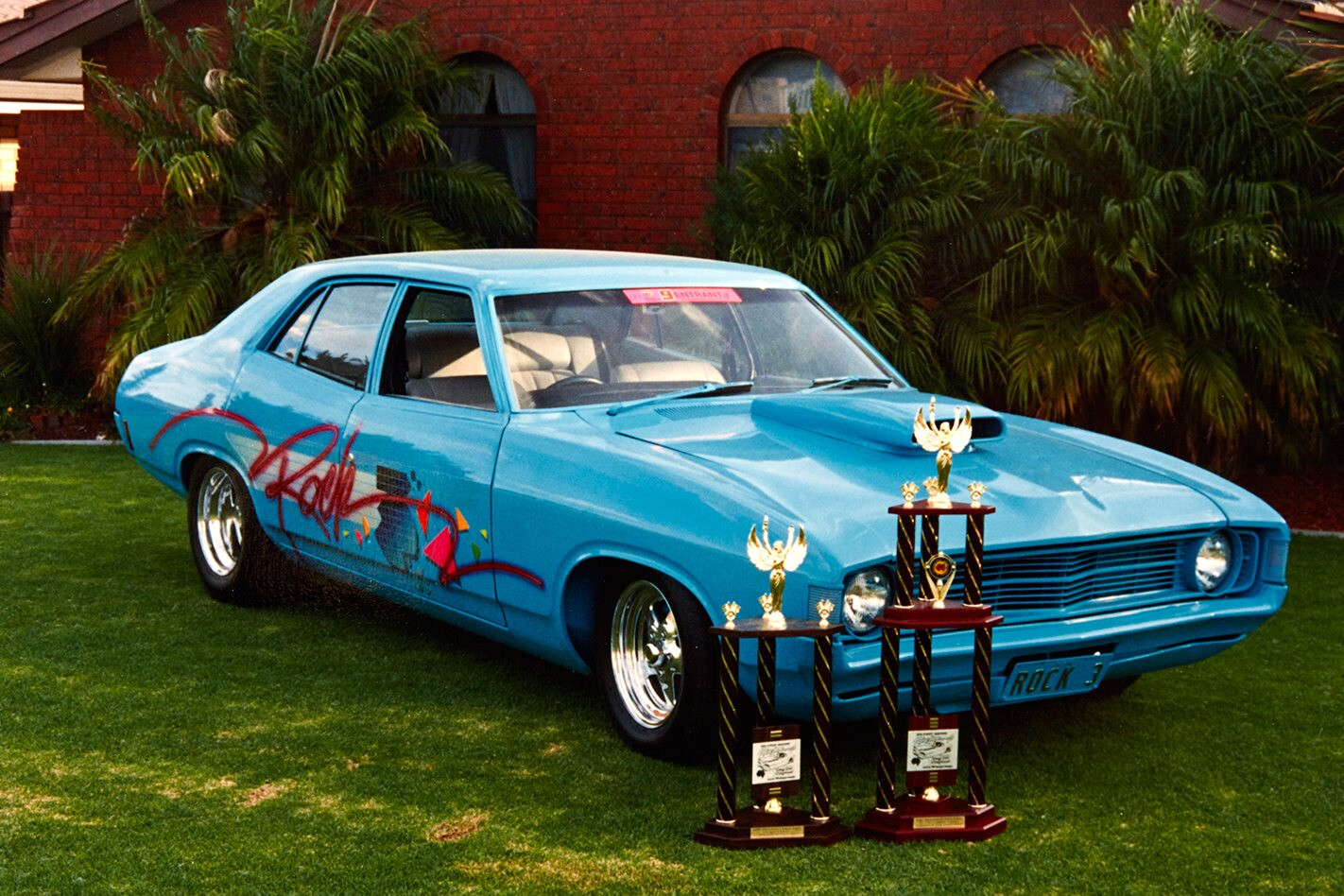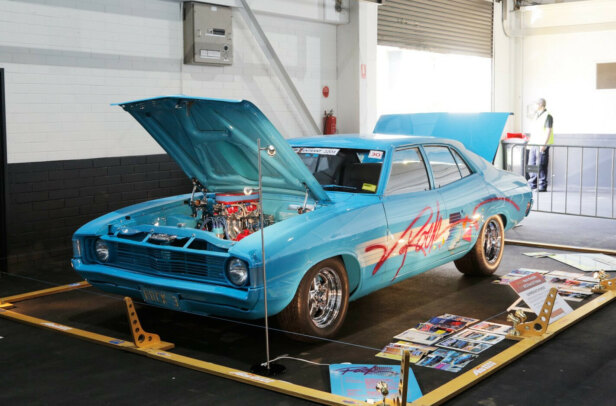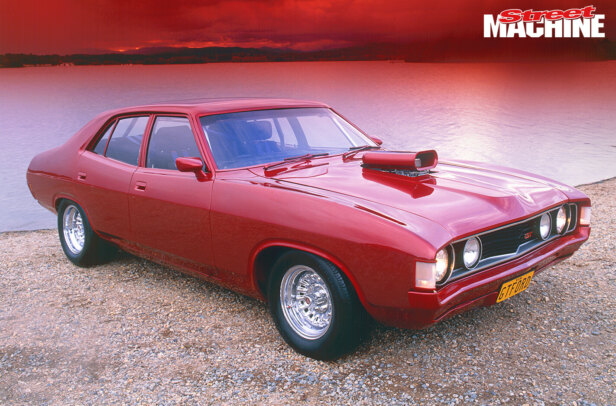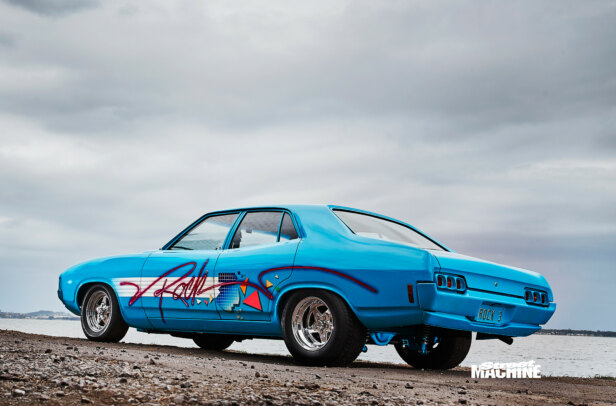IN THE March edition of Street Machine, we feature one of the most influential cars in Aussie street machining history – Howard Astill’s iconic 1972 XA Falcon – and look at the evolution it went through in the late 80s and early 90s. Here is part two of our build story with Howard himself taking us through the car’s transformation from ROCK SOLID 2 into ROCK 3.
The ROCK 3 build commences! Here’s Mark Sanders of Road Performance Modifications (RPM) taking to one of Australia’s top show cars with a nine-inch angle grinder. He’s cutting the front end out in preparation for the new stainless-steel double A-arm front end. The car is precariously sitting on the wooden blocks you can see at the front; hence the DON’T TOUCH sign on the windscreen opening
Whatever hadn’t been previously smoothed off or boxed in was given the treatment during ROCK 3’s build – this included the radiator support panel.
I give you ‘Super Diff’! Howard reckoned the smaller-diameter tubes at the ends of the original nine-inch looked wimpy. “Make it look tough,” he told Mark. He obliged by installing 3.5-inch tubes to the original centre pumpkin of the housing. The massive tubing combined with the beefy back brace made it a nine-inch on steroids!
ROCK 3 during a late mock-up stage. Looking around Howard’s garage is a lifetime of memories. Along the right is a bit of a trophy wall and hanging underneath is laminated covers of all the magazines with features of his cars.
To be able to build these cars, Howard always did as much as he could himself, so it was often a case of beg, borrow or steal. The pallet jack was a loaner from his neighbour, who was the manager of the local Coles supermarket. You can also see the mandrel bends that Howard eventually cut and welded to form ROCK 3’s exhaust system. “All the cool cars had nitrous,” Howard says, “so I had to have it as well. I’d met Rob Madden at a show, so I hit him up for one of his OZNOS systems. It was a substantial purchase at the time.”
That trick custom-made three-pod dash is the work of Lou Priori. He used a couple of individual dash fascias grafted together. The additional third pod on the left houses three VDO accessory gauges that he cut up and mounted inside a standard speedometer housing. The console is a modified unit out of an EB Falcon. “This is near the end of the build,” Howard says, “and I was running out of money. There was no budget for a fancy stereo; I reckon that factory Ford radio and the factory speaker in the kick panel was out of one of our taxis.”
“Check the calendar on the wall; the 17th and 18th are crossed off,” Howard says. “That’s the 17th and 18th of December! In less than 10 days, we finished ROCK 3, before driving 1000 kays from Broken Hill to Canberra to make it to Summernats 3. We finished putting the car together with not a minute to spare; it was very, very green.”
“Polishing my nine inch,” Howard chuckles. “All the brackets for the four-link and coil-overs were big and beefy, because that’s what Mark was doing to get things passed by Regency in South Australia.”
That’s Dave, the next-door neighbour and local Coles manager. Howard recruited him to help wet-rub the underside and engine bay. The homemade roll-over frame came in handy during all three builds.
The decision to add graphics by Ralfus to ROCK 3 dramatically complicated things. The whole car was given a light coat of clear then sanded with 800. After the graphics were laid down and smoothed over with multiple coats of clear, the entire car was then clear-coated in one continuous process, then sanded all over again.
Ralfus used his trusty overhead projector to transfer and scale up his design from a small transparency onto the side of the car. “Ralfus hand-cut the graphics on the side of the car using frisket tape,” Howard says. “I tell you what, I didn’t at all like the idea of Ralfus cutting into my fresh paint with a knife!”
This is one of the few times you get to see how much smoothing and plating Howard did under the Falcon’s guards. Ford aficionados will be all too aware that no stock XA looks this slick. The red tube is for the fire suppression system, with the wiring being routed through the factory box section/rail at the top. The rubber boot for the power windows and power door looks was also procured from an EB Falcon.
Howard discovered very early on that cars take up a lot of space when in pieces. To hold the myriad parts, he built the sturdy steel rack you see on the back wall – and it’s still being used in his workshop today, close to 30 years later!
Wanna know how they rolled back in the late 80s? Despite being one of Australia’s winningest show cars, only a few feet away from the light-blue shell you can clearly see the extractors getting a coat of heat-proof black – all while dropping the engine into place. “See all the spray guns in thebackground? Near the end there were so many things that had to be done at the same time,” Howard says.
In ROCK SOLID 1 and 2, the engine was a custom deep blue, but for ROCK 3 it was body colour. Note how the factory cylinder heads and engine block have been ground smooth and filled. The ridged water outlet was another Astill homemade billet special. With ROCK 3’s new front coil-overs mounting to a clevis welded to the inside of the shock tower, the big hole in the top was no longer needed – naturally it was plated over.
“It wasn’t until we rolled it out in the sun for the first time that we realised how much the fluoro in the graphics popped,” Howard says. “This is getting very close to Summernats.”
“We were doing a lot of outdoor shows with an indoor car,” Howard says, “so I came up with the idea of renting a marquee. We did this at Burwood in Melbourne and at the Adelaide Show ’n’ Shine. It was just me being a showman.”
“ROCK 3’s air cleaner was pretty special,” Howard says. “A local Broken Hill builder and hot rodder named Peter Ryan used to make billet parts with his woodworking tools, like his router. I sent him the dimensions, he carved it out and I got Fina-Filter to make the custom blue element. When I was cleaning up ROCK 3 for Summernats 30, I needed a new filter. Fina are no longer around and it had to be blue. So I called up Unifilter – they make blue filters. They were closing that day, yet offered to help me out. I sent them the dimensions and they made it and shipped it that day!”
“This was one of the scariest things I’ve ever done,” Howard says. “There was a skim of bog where I’d been welding up the door handles. The red hardener in the bog started to bleed through the translucent blue – arrgh! The solution was to reverse-mask to the hard edge of the graphics, spray the entire side of the car in black bleed sealer, repaint it all blue again, then re-apply the fuzzy edges to the graphics using an ordinary spray gun, as I didn’t have access to an airbrush. Frightening, yet very few people ever picked it.”
“The Riverland Cruise 1990. That’s me with my hot missus and her Flashdance-inspired hairdo, plus young Lee [Howard’s son] and Tony Baohm. Tony owned the red ’71 Trans Am with the twin Predators that was on the cover of the Street Machine issue that also featured ROCK SOLID 1 [July/Aug ’86]. I felt bloody sorry for Tony at this point; while he was working on his car at the local caravan park (which we were also staying at), he forgot that he’d left his lift-off bonnet on the ground and backed over it.”
“Had to get up at four o’clock in the morning for this Street Machine photo shoot,” Howard recalls. “That’s so we could take the shots at daybreak in this quarry, north on the way out of Canberra.”
Blue radiator hoses were a very unique feature of ROCK 3. “Plastic bumpers had just come out,” Howard says, “so I used plastic primer and added plasticiser to the blue. It lasted about two shows before the black bled through, and I’d have to repaint them again each time. You can also see the chrome nozzles for the fire suppression system on either side of the radiator.”
The 9th Street Machine Nationals, Wagga Wagga, 1990. L-R: Neville Philips’s LEGAL 8 EH [SM, Jul/Aug ’91], ROCK 3 [SM, Jun ’90] and Mark Sanders’s Torana in its original white [SM, Dec ’90]. Mark did the suspension on all three cars.
After debuting ROCK 3 at Summernats 3, Howard continued to refine the car over the next 12 months before Summernats 4. “I was never happy with the finish on the underside of the bonnet,” he says. “With all the exposed bits and pieces it’s hard to get a good finish when you paint it all in one go. So I masked it off and repainted it. There were a host of little things like this that were improved. It made a massive difference between Summernats 3 and 4; continual refinement is why we took out Top Judged at 4.”
On the front lawn of Howard’s Broken Hill home, proudly displaying Entrant’s Choice and Top Street Machine trophies from the 9th Street Machine Nationals.
Renowned motor trimmer Ron Lingard was based in Broken Hill at this stage, and did the trim in ROCK 3 – the Falcon’s first professional trim job. Howard and Ron took inspiration from CadZZilla. The retractable seatbelts were very cutting-edge for the day, while switches for the rear power windows were located in the centre console.
Ralfus doing the Toyota ‘oh what a feeling’ leap in front of his two works of art; the Chevy Nova also debuted at Summernats 3. Howard was pissed at Ralfus for using such a similar design on another car before ROCK 3 debuted – one of the magazines had to convince Howard to take part in this shoot.
For ROCK 3 the drag race-only ladder bars made way for a proper four-link and Z-bar. Notice how the voids in the bumper bar around the number plate have all been filled and smoothed over. And in keeping with the sleek lines and no edges theme of ROCK 3, that nice, tidy number plate light is yet another EB Falcon item.
“The accepted rule was, never use fluoro lights in your display as it shows off all the imperfections,” Howard says. “At the 1990 Brisbane Hot Rod Show I deliberately incorporated them so the judges and spectators could follow the line of the light down the side of the car and see how good it was. This was another stand that was a pain in the arse to put up. While at the show, I did the deal with Chic Henry over lunch for him to buy ROCK 3 as the Summernats 4 giveaway car.”
Summernats stand, 1990 Sydney International Motor Show. “Part of my deal with Chic included taking the car to shows to help him sell programs. You bought a $5 Summernats program and you got one free entry into the draw. We did a lot of shows and sold a shitload of programs. I even took the car to the Bathurst 1000; I’ve got photos of it out on Pit Straight. I’ve still got the ‘Win this Car’ poster board!”
The 1996 Muscle Car & Mega Bike show at what is now Fox Studios. Chic arranged for ROCK 3, the ROCK 4 Fairlane and the Pioneer Coupe (later Race Rock) to be there. This is the only time all three of these Astill builds have been in the one place at the one time.
Another shot from the 1990 Sydney International Motor Show. “Unfortunately I cannot remember the young lass’s name, but she was Miss Summernats,” Howard says
“This was our outdoor spray booth,” Howard explains. “I still can’t get over what we used to get away with at the time.”
The 1990 Melbourne Hot Rod Show. “I upset a few of the hot rodders by taking out a lot of the major outright awards – with a street machine!” Howard says. “One of the more controversial awards I won was Top Engineered. The hot rodders complained: ‘You can’t have a street machine win Top Engineered’! The judge actually came up to me later in the show and commented that he was very happy that I won it.”
“I’ve always loved drag racing,” Howard says. “At the 1988 Adelaide Hot Rod & Street Machine Spectacular I had already decided that I was going to go home and pull the car apart, so I thought if I was ever going to f**k something up, now is the time to do it. So when the opportunity came up to run it at AIR I jumped at the chance. I was pretty happy with my [email protected] timeslip.”
“How’s this for karma? I was still selling programs for Chic during Summernats 4. At the end of the weekend, after Mario Montalto’s name was drawn out [as the winner of ROCK 3], he came by to collect the keys and told me that I made him fill out the winning entry. When he bought the program he told me he’d fill out the entry and drop it back later on. Apparently I shouted out to him: ‘Come back here and fill it in now, otherwise you’ll go get pissed with your mates and you won’t do it.’ I not only sold him the winning entry, I gave him the pen and made him fill it out!”
AWARDS
1986 7th Street Machine Nationals, Canberra
Top 60
1986 SA Hot Rod & Street Machine Spectacular
2nd 1971 & On
1986 Riverland Cruise
Top Street Machine, Entrants’ Choice, People’s Choice
1986 8th SMASA Show ’n’ Shine, Adelaide
Top Sedan
1987 Vic State Titles
Top Street Machine Overall, Top Engine
1987 SA Hot Rod & Street Machine Spectacular
Top Mild Custom
1988 8th Street Machine Nationals, Wagga Wagga
Top Judged, Entrants’ Choice
1988 SA Hot Rod & Street Machine Spectacular
Top Engine
1988 Rickshaws Hot Rod & Performance Show
Top Street Machine
1989 Summernats 2
Top 10, Top Undercarriage/Driveline, Top Engineered Street Machine, Top Engine Bay, Entrants’ Choice
1989 Melbourne Hot Rod Show
Top Exhibition Vehicle, Top Engine Bay
1989 8th Victorian Custom Car Spectacular
Drivetrain, 2nd Overall
1989 9th SMASA Show ’n’ Shine
Top Street Machine of Show, Best Ford
1989 Vic State Titles
Top Judged, Entrants’ Choice
1990 Summernats 3
Top 10, Top Mild Custom, Top Interior, Top Graphics
1990 Melbourne Hot Rod Show
Top Street Machine
1990 10th SMASA Show ’n’ Shine
Top Street Machine, Top Interior, Best Engineered
1990 9th Street Machine Nationals, Wagga Wagga
Top Street Machine Overall, Entrants’ Choice
1990 Brisbane Hot Rod Show
Top Sedan, Top Engineered, Top Custom Paint
1990 SA Hot Rod & Street Machine Spectacular
Top Street Machine Overall
1990 NSW State Titles, Penrith
Top Street Machine Show Class, People’s Choice, Top Engineered
1991 Summernats 4
Grand Champion, Top Judged, Top Sedan, Top Engine Bay, Top Undercarriage




Comments